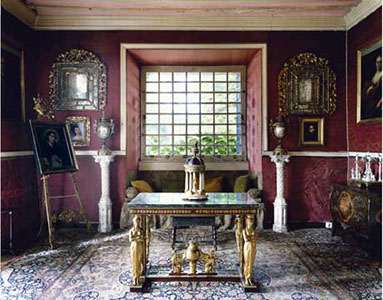 |
Contrary to what one might expect from a show titled "Decline and Fall", this is not an exhibition about the demise of the American Dream — or about anything else that’s in the news. This show skirts topicality almost completely and focuses instead on the meltdown and transformation of the hierarchies that surround us. Modes of artistic expression, interpretations of history, shifting gender roles, the dissolution of middle-class values and vanities, linguistic incoherence and the fact of our own corporeal demise are among the topics addressed by the 12 artists assembled here by gallery co-director Jenny Baie. [A short Q&A with Ms. Baie follows this review.]
Key among the those charting such transformations is Candida Höfer. For years, her super-sized images of public spaces have commanded rapt attention. She, along with her counterparts in the Dusseldorf School of Photography, helped rehabilitate the once-discredited idea of photographic veracity with hyperreal images of stunning clarity Still, I have never been able to shake the feeling that Hofer siphons all the oxygen out a room before taking a picture. And it’s precisely that leaden quality that makes her appearance in “Decline and Fall” feel so right. The picture on view here, “Palacio Peredo-Barreda de Caja Cantabria Santillana del Mar I” (2004), shows the interior of a once-grand palace that is now a bit down at the heels. It’s a pliable mascot of sorts, one whose tarnished grandeur functions as a symbol for the demise of practically every established order you can think of.
In addition to Höfer, the show includes Doug Hall, Martin Klimas, Ian McDonald, Andrew Moore, Vik Muniz, Joseph Park, Deborah Oropallo, Marci Washington, John Waters, Fred Wilson and Bing Wright. Appropriately, it leans heavily toward photography and on photo-based hybrids.
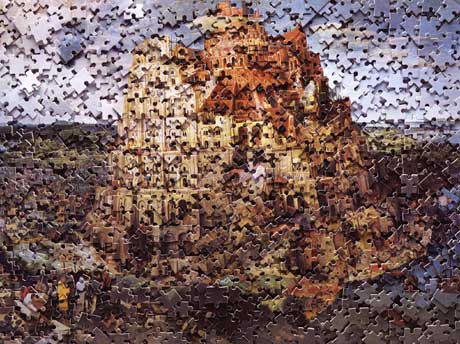 |
The most notable of these is Vik Muniz whose “Gordian Puzzles: The Tower of Babel, after Pieter Breugel” (2007) transforms the Dutch artist’s 1563 painting, of a crumbling citadel, into a jigsaw puzzle whose pieces were conjoined in a fractured, three-dimensional collage and then photographed. The resulting image is as confounding as the knot that Alexander the Great is said to have cut in one fell swoop. But the Gordian conundrum, if I read Muniz correctly, is far simpler than anything we face today; we are as deafened by the din of our own bickering as we were in Biblical times.
.jpg) |
 |
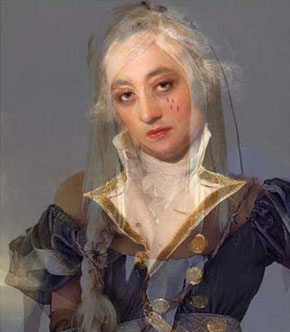 |
The two paintings here, "Maid with Squirrel" (2008) and “Repunzel” (2008), both from her "Feign" series, are somewhat less complex, but just as psychologically loaded. Based on downloaded images of models, they are digitally manipulated and then ouput as paint on canvas. They are, if nothing else, magnificently decadent, as the "heroin-chic" affection of "Repunzel" attests.
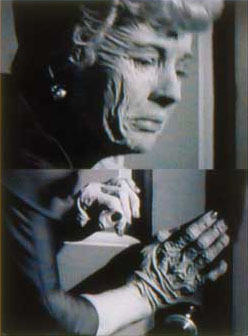 |
Film director/photographer John Waters, the high priest of high camp (and as of late, a marquee name on Broadway), frames the concept of decline and fall in personal terms: in a gruesomely altered film still of a woman whose sagging face and wrinkled hands look like something Joel Peter Witkin might have created had he gotten hold of Joan Crawford in her role in “What Ever Happened to Baby Jane?”. Waters used the picture to commemorate his 60th birthday in 2006.
Just as creepy is Marci Washington’s high-Goth painting “To Walk These Halls – Unnamed and Unmourned” (2009). With a disintegrating skeleton set against patterned wallpaper, it warns (according to the artist) that our repression of history is akin to a skeleton in the closet. The Freudian part rings true, but the picture is too simplistic to carry the idea. By contrast, culture warrior Fred Wilson’s attempt to Africanize the Euro-centric view of art history – by inserting an Egyptian figurine into a Greek bust – is as clever as it is subversive. But one wonders how it wound up next to the over-aestheticized Hallmark sentiment conveyed in Bing Howard’s photo of fallen rose petals.
Decline and Fall” casts a wide net. That it pulls in everything but topical news is a decisive victory for a concept that is as wide-open as the unwritten history of our times.
Q&A with Curator/Co-Director Jenny Baie
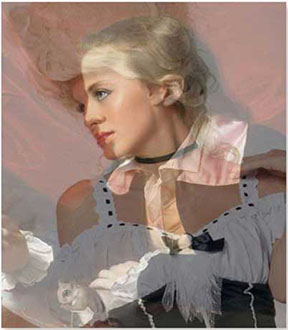 |
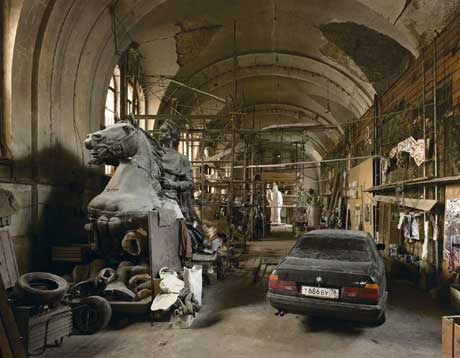 |
.jpg) |